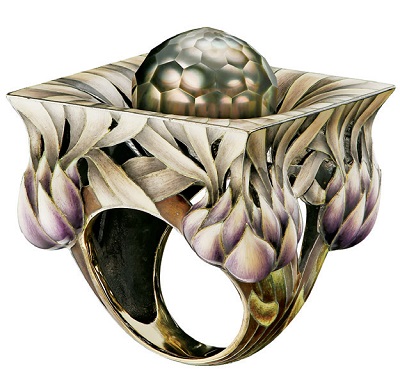The Art of Enamelling

The Beginning
The ancient Egyptians applied enamels to stone objects, pottery, and sometimes jewellery. The ancient Greeks, Celts, Georgians, and Chinese also used enamel on metal objects. Even Romans used it to decorate glass vessels. According to Wikipedia,during those times enamel powder could be produced in two ways, either by powdering coloured glass, or by mixing colourless glass powder with pigments such as metallic oxide. Designs were either painted freehand or over the top of outline incisions, and the technique probably originated in metal working. Once painted, enamelled glass vessels needed to be fired at a temperature high enough to melt the applied powder, but low enough that the vessel itself was not melted. Ancient Persians used this method for colouring and ornamenting the surface of metals by fusing over it brilliant colours that are decorated in an intricate design and called it Meenakari.
In European art history, enamel was at its prime in the Middle Ages, beginning with the Late Romans and then the Byzantine, who began to use cloisonné enamel in imitation of cloisonné inlays of precious stones. The cloisonné technique reached China in the 13–14th centuries. More recently, the bright, jewel-like colours have made enamel a favoured choice for jewellery designers, including the Art Nouveau jewellers, for designers of bibelots such as the eggs of Peter Carl Fabergé and the enameled copper boxes of the Battersea enamellers, and for artists such as George Stubbs and other painters of portrait miniatures.

Famous techniques of enamelling
Champlevé
Champlevé, the name comes from the French word meaning “raised fieldâ€. For this, the surface is carved out to form pits in which enamel is fired, leaving the original metal exposed. Once the enamel has been fired, then the object is filed and polished, leaving the non-indentedareas without enamel. This enamel is created with a single piece of metal.
Cloisonné
Cloisonné, the name comes from the French word ‘cell’. For this, thin wires are placed to form raised barriers on a base metal sheet. The wires are soldered to the surface and then the barriers are filled with enamel. After that it’s fired, filed and polished, leaving the wire borders uncoloured.
Plique-Ã -jour
Plique-à -jour, French for “open to daylight†is a technique where the enamel is applied in cells, similar to cloisonné but with no backing, so that light can shine through the transparent or translucent enamel. It has a stained-glass like appearance.

It is a type of painting with enamels done on a smooth metal surface. In this technique a, slightly convex, metal plate is covered with a fondant of uniform colour which was fired to produce a vitreous base for the drawing. On this the artist starts applying colour after colour in thin layers onto the base colour with a paint brush. Grisaille and Limoges enamel are types of painted enamel.
Grisaille
Grisaille enamel involves working with white pigments on a black background. To do so, the metal base is first covered with a layer of black enamel. However, the most difficult aspect of this is to obtain a deep, smooth black layer with no impurities, which will be able to withstand multiple firings. This technique is now used in jewellery and as a decoration for watches.
Meenakari This mainly involves covering a metal object with coloured enamels. Red, Green and white enamels dominate in this art. The metal used is called ‘chitras’. In Rajasthan, this art was introduced by Raja Mansingh of Amer. Jaipur is a renowned centre for Meenakari art form. Varanasi is well-known for Gulabi Meenakari while Nathdwara, Bikaner and Udaipur are famous for silver Meenakari. In Gulabi Meenakari, as the name suggests, pink is the dominant colour.
Types of Meenakari include ‘Ek Rang Khula Mina’ which involves the use of single colour transparent enamel. The engraved area is filled with single enamel leaving gold coloured outlines exposed around figural details. Panch Rang Mina uses enamels of five colours - Safed– opaque white, Fakhtai– opaque light blue, Fakhta – a dove, Khula Nila– transparent dark blue and Khula Sabz– transparent green.

Lesser known enamelling techniques
Basse-taille involves creating a lowrelief pattern in metal, usually silver orgold, by engraving or chasing. Ronde bosse is a 3D type of enamelling where a sculptural form or wire framework is completely or partly enameled. Flinqué Enamel involves depositing enamel colour by means of a quill pen or brush on a sheet of metal (gold or silver) previously decorated with engraving by hand or with a guilloche. Paillonné enamelling is a 19th century technique of applying layers of translucent coloured enamel over very fine sheets of silver or gold resulting in dramatically bright and brilliant colours. Enamel techniques like Flinqué and Paillonné might be lesser known but they have been used by high-end luxury watch makers like Ulysse Nardin, Hermès, Cartier, etc.
Be the first to comment